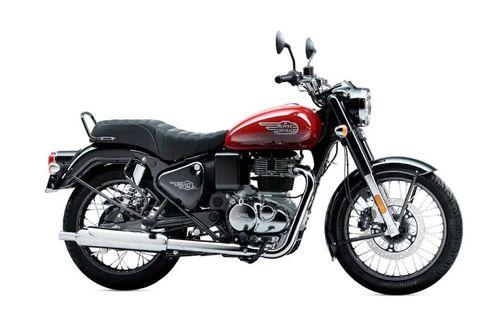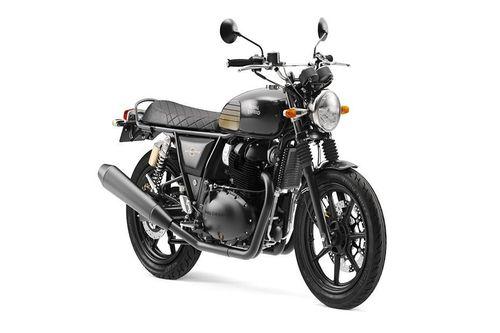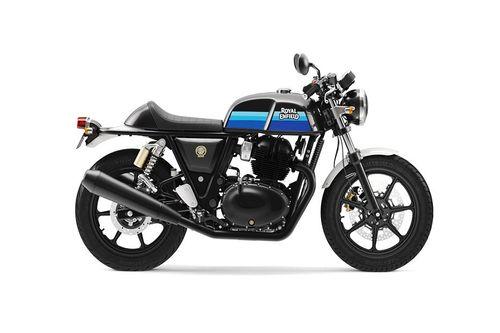About Royal Enfield Bikes
Royal Enfield's story began in 1891 when George Townsend & Co. in Redditch, England, started manufacturing bicycles. The company was renamed the Enfield Manufacturing Company Ltd. in 1893, inspired by the town of Enfield, where its factory was located. Adopting the slogan "Made Like a Gun," the brand emphasized strength and reliability. In 1898, Enfield began experimenting with motorized vehicles, producing quadricycles powered by a small De Dion-Bouton engine.
The first Royal Enfield motorcycle debuted in 1901, featuring a 1.5-horsepower engine mounted in a bicycle frame. This made Royal Enfield one of the oldest motorcycle manufacturers still in production today.
1900s–1920s: Early Innovation and Wartime Contributions
The early 20th century saw Royal Enfield introducing innovative motorcycles to cater to a growing market. The company experimented with V-twin engines and sidecar combinations. The Royal Enfield Model 180 became popular for its reliability.
During World War I, Royal Enfield supplied motorcycles to the British armed forces. Models like the Model 6 HP equipped with sidecars and Vickers machine guns showcased the brand’s versatility and ruggedness.
Post-war, Royal Enfield focused on civilian models, launching the Model 500 Twin and 350cc motorcycles. These bikes gained popularity in both domestic and international markets.
1930s: The Golden Age of British Motorcycling
In the 1930s, Royal Enfield became a significant player in the British motorcycle industry. Models like the Bullet, introduced in 1932, featured advanced engineering for the time, including a four-valve engine. The Bullet would later become synonymous with the Royal Enfield brand.
During this period, the company also ventured into lightweight motorcycles, producing bikes with engines ranging from 125cc to 500cc. These were aimed at both commuters and enthusiasts.
1940s: World War II and the Flying Flea
World War II brought another wave of military contracts for Royal Enfield. The company produced rugged motorcycles for the Allied forces, including the legendary Flying Flea (RE/WD 125). This lightweight two-stroke bike was designed to be dropped behind enemy lines via parachute and used by airborne troops.
After the war, Royal Enfield resumed civilian production and introduced new models to meet the demands of returning soldiers and the growing global market.
1950s: Entry into India and the Rise of the Bullet
The 1950s marked a turning point for Royal Enfield with its entry into the Indian market. The Indian government sought sturdy motorcycles for the army and police, leading to the import of the Bullet 350. The bike’s rugged design and performance in tough terrains made it a favorite among Indian authorities.
In 1955, Royal Enfield partnered with Madras Motors to establish Enfield India. Initially, the company imported parts for local assembly, but full-scale production of the Bullet 350 began in India by 1957.
In the UK, Royal Enfield introduced models like the Meteor and Constellation, which catered to the growing demand for high-performance motorcycles.
1960s: Global Expansion and Challenges
The 1960s saw Royal Enfield expand globally, exporting motorcycles to the US, Europe, and Australia. The Interceptor 700, launched in 1962, was a powerful twin-cylinder motorcycle designed for the American market. It gained a cult following for its performance and styling.
However, the rise of Japanese motorcycle manufacturers like Honda and Yamaha posed a significant challenge. Their advanced technology, reliability, and affordability began to overshadow British manufacturers.
In 1967, Royal Enfield ceased operations in the UK due to financial difficulties. However, Enfield India continued production, keeping the brand alive.
1970s–1980s: Survival in India
While Royal Enfield’s global presence waned, the Indian subsidiary thrived. The Bullet 350 became deeply ingrained in Indian culture, symbolizing ruggedness and reliability. Enfield India introduced minor upgrades to keep the model relevant, but the brand largely retained its classic appeal.
In 1977, Enfield India began exporting the Bullet to Europe and the US, rekindling interest among enthusiasts who admired its retro charm.
1990s: Acquisition by Eicher Motors
The 1990s brought a revival for Royal Enfield. In 1994, the Indian tractor and automotive manufacturer Eicher Motors acquired Enfield India. Under Eicher's leadership, Royal Enfield began modernizing its production facilities and improving the quality and reliability of its motorcycles.
The company also focused on branding, capitalizing on the Bullet’s vintage appeal to attract a new generation of riders. By the late 1990s, Royal Enfield had started gaining traction in international markets as a niche brand offering classic motorcycles.
2000s: The Global Comeback
The early 2000s marked a period of transformation for Royal Enfield. The introduction of the UCE (Unit Construction Engine) in 2008 modernized the Bullet lineup while retaining its classic aesthetics. This engine met modern emission norms and improved performance and fuel efficiency.
Royal Enfield also expanded its product lineup, introducing models like the Classic 350 and Classic 500. These bikes combined vintage styling with modern engineering, appealing to a global audience.
2010s: Rebuilding the Brand
Under the leadership of Siddhartha Lal, Royal Enfield underwent a major resurgence. The company opened state-of-the-art manufacturing facilities in Oragadam and Vallam Vadagal, India, to meet growing demand.
The introduction of new models like the Himalayan (2016) and Interceptor 650 (2018) marked a shift toward adventure and performance-oriented motorcycles. The Himalayan became a popular choice among adventure enthusiasts, while the Interceptor 650 and Continental GT 650 gained acclaim for their performance, retro design, and affordability.
Royal Enfield also invested in global R&D centers, including one in the UK, to develop cutting-edge technology while preserving the brand’s heritage.
2020s: Electric Mobility and Modernisation
In the 2020s, Royal Enfield continues to dominate the mid-size motorcycle segment globally. The company launched new models like the Meteor 350 and the next-generation Classic 350, featuring the J-series engine platform, which offers smoother performance and modern technology.
Royal Enfield has also announced its plans to enter the electric motorcycle segment, aiming to combine sustainability with its iconic design language. Prototypes of electric models have already been teased, signaling the brand's commitment to innovation.
Racing and Cultural Impact
Royal Enfield's association with endurance racing and long-distance travel has further enhanced its legacy. Events like the Himalayan Odyssey and One Ride celebrate the spirit of motorcycling, fostering a global community of Royal Enfield enthusiasts.
Legacy and Global Appeal
Today, Royal Enfield is a symbol of timeless design, adventure, and individuality. With a presence in over 60 countries and a strong foothold in both traditional and emerging markets, the brand continues to inspire riders worldwide. Its ability to blend heritage with modernity ensures its place as one of the most iconic motorcycle manufacturers in history.
USP: The Royal Enfield Experience
Royal Enfield’s USP lies in its blend of heritage, simplicity, and versatility, catering to both urban riders and off-road adventurers. Its core USPs include:
Heritage and Legacy: With over 120 years of history, Royal Enfield is a name steeped in tradition. Iconic models like the Bullet have earned legendary status worldwide.
Classic Design with Modern Engineering: The motorcycles retain vintage aesthetics like teardrop tanks and round headlights while incorporating modern features like EFI (Electronic Fuel Injection) and ABS.
Unmatched Ride Experience: Known for their characteristic "thump" sound, Royal Enfield bikes deliver a relaxed, low-revving riding experience ideal for highways and off-road adventures alike.
Wide Product Range: From the classic Bullet 350 to the rugged Himalayan and the retro-modern Interceptor 650, Royal Enfield offers motorcycles that cater to a variety of riding styles and terrains.
Community and Riding Culture: The brand fosters a global community through events like the Himalayan Odyssey, Rider Mania, and other group rides, making ownership a lifestyle choice rather than just a purchase.
Royal Enfield Latest Updates
- Royal Enfield experienced a significant boost in sales during the festive season, dispatching 1 lakh units in October 2024. This resurgence followed a period of decline from May to August, with the festive demand driving a 26% increase in retail volumes.
- Royal Enfield confirmed the global debut of its first electric bike on November 4, 2024. The new electric model is expected to feature a retro roadster design, blending classic aesthetics with modern electric technology.
- Royal Enfield saw robust growth in rural markets during October 2024, with rural areas contributing about one-third of the brand's domestic volume. This growth highlights the brand's strong presence and appeal in both urban and rural regions
Royal Enfield Bike Series
Royal Enfield offers a diverse lineup of motorcycles catering to various riding preferences and styles. Here are the key models currently available in India:
- Classic 350
- Hunter 350
- Himalayan 450
- Meteor 350
- Bullet 350
Royal Enfield Bike Price Range (ex-showroom)
Racing and Cultural Impact
Royal Enfield's association with endurance racing and long-distance travel has further enhanced its legacy. Events like the Himalayan Odyssey and One Ride celebrate the spirit of motorcycling, fostering a global community of Royal Enfield enthusiasts.
Royal Enfield Dealers
Royal Enfield has approximately 1,921 dealerships in 756 cities across India. This extensive network ensures that Royal Enfield motorcycles are accessible to a wide range of customers throughout the country.
Locate the nearest dealer using the official dealer locator tool: Royal Enfield Dealer Locator
Service Centres
Royal Enfield’s widespread service network ensures that its motorcycles are well-maintained, no matter where the journey takes its riders. The company emphasizes quality service through its 900+ authorized service centers in India.
The brand’s official website offers a locator tool to find the nearest service center: Royal Enfield Service Centre.
Royal Enfield Toll-Free Number
Model | Price |
Classic 350 | ₹1,99,499 |
Hunter 350 | ₹1,49,900 |
Himalayan 450 | ₹2,85,000 |
Meteor 350 | ₹2,05,528 |
Bullet 350 | ₹1,73,562 |
Scram 411 | ₹2,06,000 |
Continental GT 650 | ₹3,18,418 |
- For Roadside Assistance (RSA): 1800 2100 007
- For Customer Support: 1800 2100 008
How to get a Bike Loan in India
Check your eligibility, which typically includes being at least 21 years old with a stable income and a good credit score. Compare loan offers from various banks and NBFCs to find competitive interest rates and favorable terms. Use an EMI calculator to estimate your monthly payments. You can apply for the loan online through the lender's website or in person at a branch. Submit the required documents, such as identity proof, address proof, income proof, and a bike quotation from the dealer. If you have a good relationship with your bank, you might also be eligible for pre-approved loans with quicker disbursement.
Why choose CarBike360?
CarBike360 is a reliable resource for investigating, contrasting, and buying automobiles, including bicycles. It provides the most recent information about bike costs and availability in India, together with comprehensive specifications, reviews, and an intuitive user experience. You can check pricing in real time, get professional advice, and make well-informed selections with CarBike360.




























































